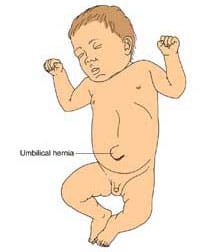What is an Umbilical Hernia?
An umbilical hernia is an abnormal bulge that can be seen or felt at the umbilicus (belly button). This hernia develops when a portion of the lining of the abdomen, part of the intestine, and / or fluid from the abdomen, comes through the muscle of the abdominal wall.
Umbilical hernias are common, occurring in 10 percent to 20 percent of all children. They are more common in African-Americans.
Low birth weight and premature infants are also more likely to have an umbilical hernia. Boys and girls are equally affected.
Causes of Umbilical Hernia
As the fetus develops during pregnancy, there is a small opening in the abdominal muscles that allows the umbilical cord to pass through, connecting mother to baby.
As the baby grows after birth, this opening in the abdominal muscles closes. Sometimes, however, these muscles do not meet and grow together completely, and a small opening remains. This opening is called an umbilical hernia.
Signs and Symptoms of Umbilical Hernia
Umbilical hernias appear as a bulge or swelling in the belly button area. The swelling may become more noticeable when the baby cries and may become smaller or disappear when the baby is quiet. If a doctor gently pushes on the bulge when a child is lying down and calm, it will usually get smaller or go back into the abdomen.
Sometimes the intestines get trapped within the umbilical hernia. This is referred to as an incarcerated hernia. When this occurs, the child usually has severe pain and the bulge may be firm and red. Urgent medical evaluation to exclude an incarcerated hernia is required in order to prevent possible damage to the intestines. It is uncommon for this to occur.
Diagnosis of Umbilical Hernia
Physical examination by a doctor can diagnose an umbilical hernia and can also determine if there are any abdominal contents caught in the hernia sac.Treatment for Umbilical Hernia
Many umbilical hernias close son their own by ages 3 to 4. If closure does not occur by this time, surgical repair is advised. In younger children, if there is an episode of incarceration or if the hernia is very large, surgical repair may be recommended.
Surgery to repair the hernia is performed under general anesthesia.
A small incision is made at the base of the belly button. If any intestine is present in the hernia, it is placed back into the abdominal cavity. The opening in the muscle is then repaired with multiple layers of stitches to prevent another hernia. A dressing and / or incision glue is placed to keep the belly button flat.
While premature infants and children with certain medical conditions may require overnight observation in the hospital, most children are able to return home within a few hours after surgery.
Long-Term Outlook
Once the hernia is closed, it is unlikely that it will reoccur. However, the risk of recurrence is increased in patients who have wound infections following surgery.




